 OBEDIENCE
OBEDIENCE
 OBEDIENCE
OBEDIENCE
Why formal obedience training? Many, many, many reasons!
As we said earlier, basic obedience training is the bases of trick training.
What we found was that classroom training helped us to back up a step and put things in perspective.
We looked around. Found a trainer that seemed compatible, as well as knowledgeable, when we introduced Tory to formal obedience. Tory was twelve weeks old, but puppy classes weren't what we were looking for.
So, the youngest member of the basic obedience set took the floor. We did not abandon our Pearsall Guide, our training bible, over many years, however.
The Pearsall Guide is not the only dog training manual that we use, but it is the best. So, we can play with a variety of ideas gleaned from our books, but nothing replaces practical experience. In formal classes, you will meet many experienced people, besides your trainer. You will observe, and ask, and get answers; you are paying for the experience.
Tory stays with a stranger 3 minutes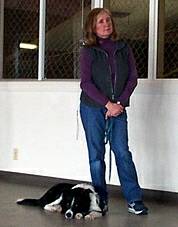 dad makes phone call, out of sight.
dad makes phone call, out of sight.
Our trainer had other experienced trainer/handlers in his classes. Why, we believe, to sharpen their skills. A different perspective is important. One trainer/handler told me that this man was heavy handed, not a surprise, I'd seen that myself, but he had a wealth of experience, a lot to offer.
"The most important lesson is that you take away that which works for you."
We are all individuals and so are our companions.
We constantly referred to our Pearsall Guide. None the less, formal classes were important. Tory socialized with other dogs, and we learned a great deal, not only about what wasn't in the books, but how to interpret much of what we read.
Professional, we are not. Experienced, we are. And because, we could not interest a professional in our brilliant little deaf boy, we would like to talk a little about our experiences, starting with each dog is an individual with individual needs.
 For instance, basic obedience prefers come to heel left, because there is less chance of error, BUT
For instance, basic obedience prefers come to heel left, because there is less chance of error, BUT
 Patches responds better to come to heel right. Tory isn't particular because we taught both methods at home.
Patches responds better to come to heel right. Tory isn't particular because we taught both methods at home.
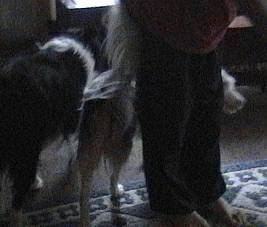 and
and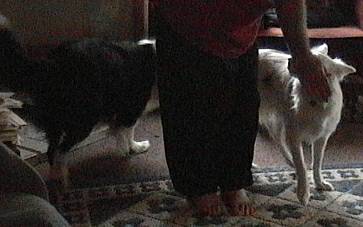 stop
stop
 thumbs up - good boys
thumbs up - good boys
Note that the boys are learning to work together, off lead, because dad is lazy. What it means is that to look impressive, a lot of repetition will be necessary. Basic obedience instruction, work the dogs on lead almost always, probably good advice.
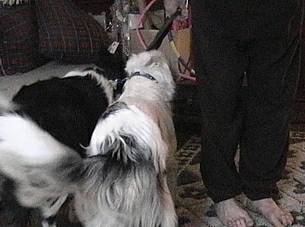 *
*
On lead is somewhat cleaner.
The point here is that Patches finds the come to heel right signal easier to follow. Do what works, experiment!
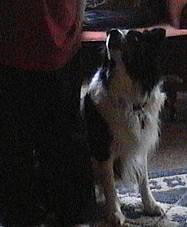 This is actually 'close', a pat on the leg with the hand, and should be performed correctly. However, a deaf dog needs to see you, and should not be expected to get all that 'close' without a great deal of work. Make allowances. Do not force junior into a position where he can not really see your signals. Remember, the most important signal early on is probably
This is actually 'close', a pat on the leg with the hand, and should be performed correctly. However, a deaf dog needs to see you, and should not be expected to get all that 'close' without a great deal of work. Make allowances. Do not force junior into a position where he can not really see your signals. Remember, the most important signal early on is probably
'watch me'. 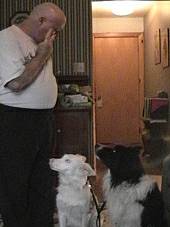 *
*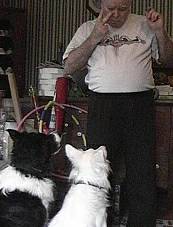
The classes that I attended, insisted on verbal commands for basic obedience. Somehow I doubt that deaf Patches would be impressed.
Each dog is an individual!